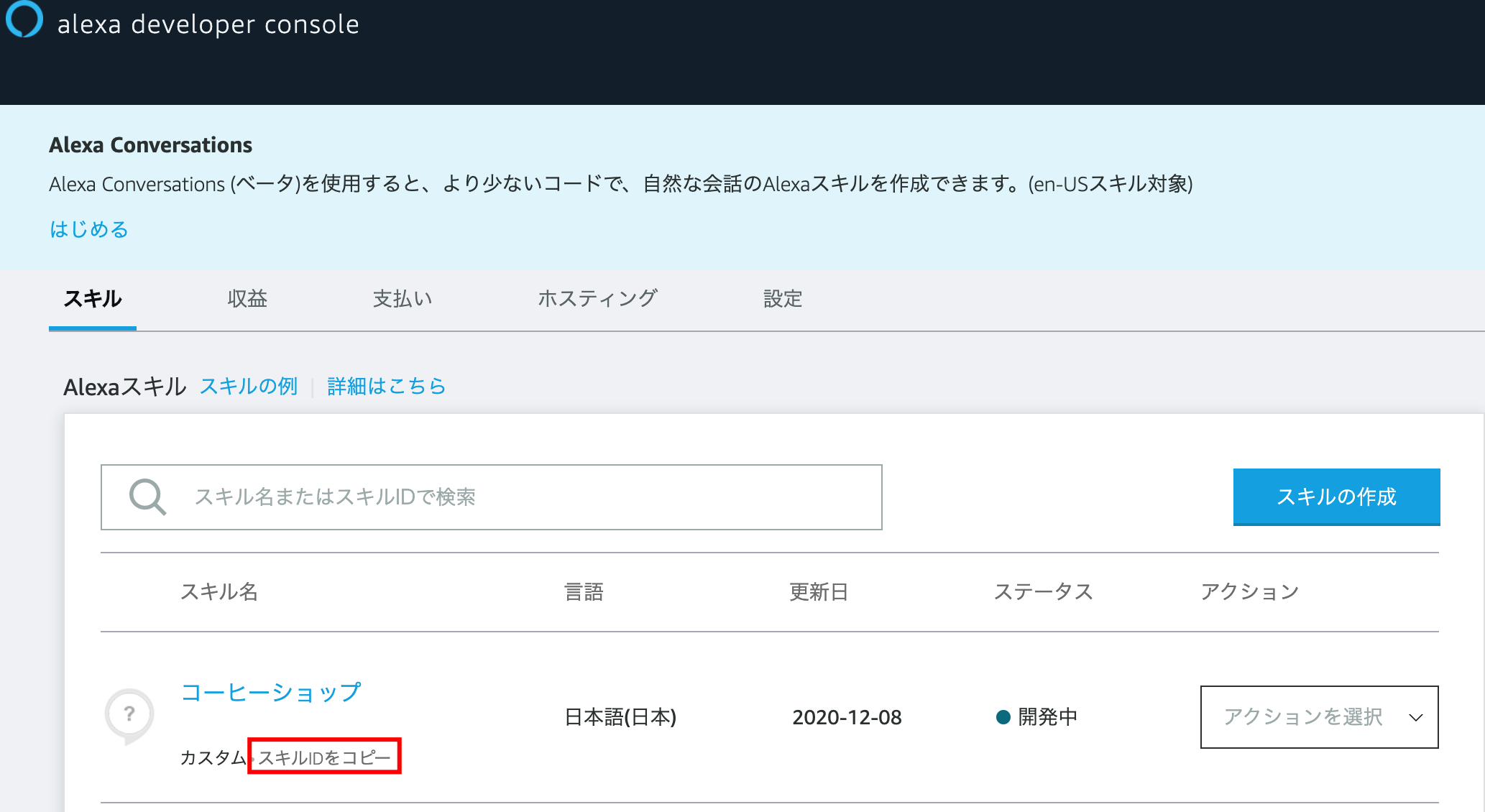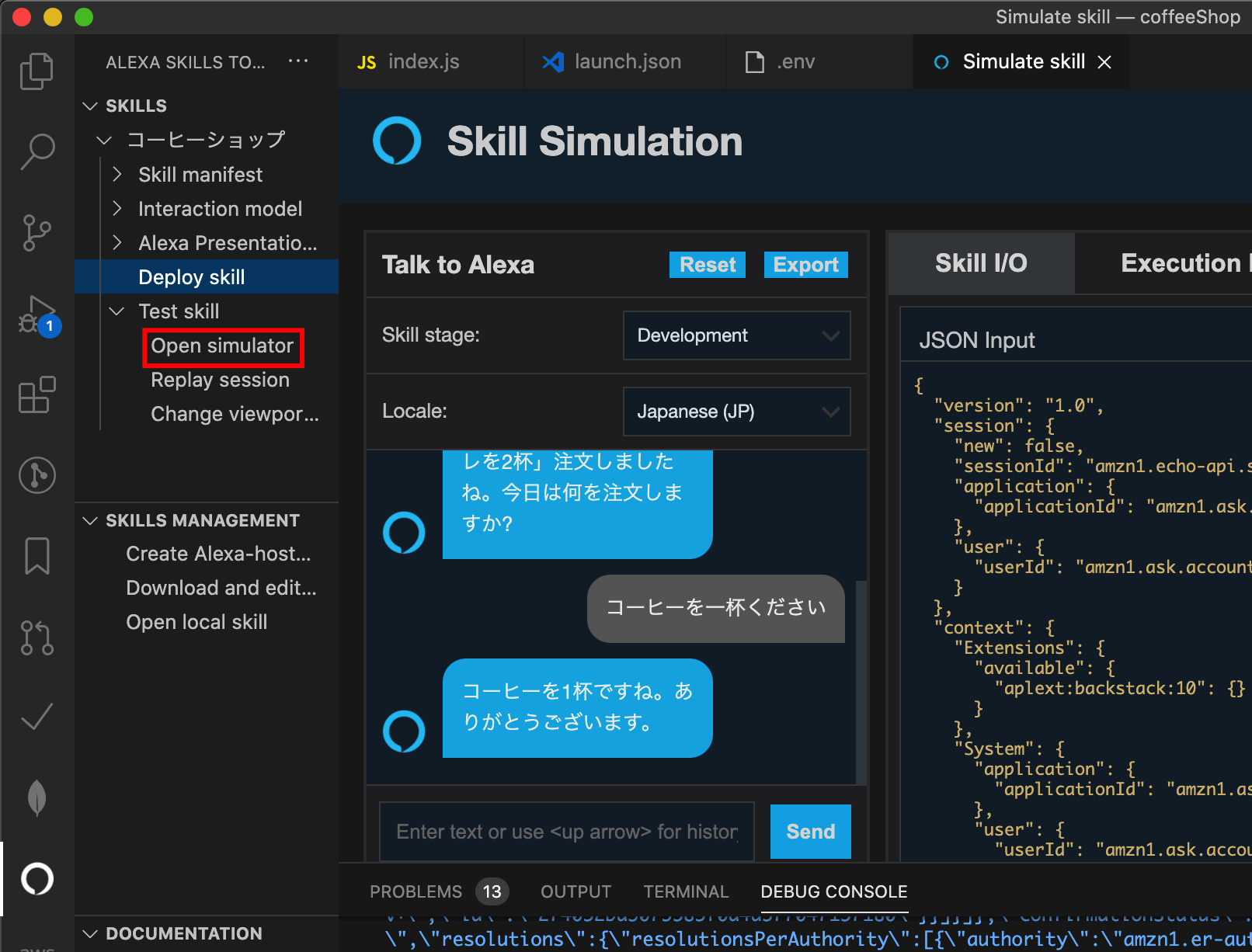Alexa 開発を始めました。Alexaちゃんの声は、Googleアシスタントの声より個人的には好きです。プログラムで思い通りに喋らせることができると楽しいです。
AWS のチュートリアルは親切でわかりやすい。皆さんもやったと思いますが、「コーヒーショップ」を作りました。
日本語ビデオ版(日本語ブログ版でも)では「永続アトリビュート(データ)」を S3 にテキスト形式で保存するように説明されていますが、Alexa-hosted スキルでも DynamoDB が使えるようになっているので、こちらの方法でやってみます(AWS でも DynamoDB が推奨されています)。
引っかかったところは、ローカルでのデータベーステストでした。本番環境で問題ないコードですが、ローカルテストでは、エラーになってしまいます。
~~~~ Error handled: {"name":"AskSdk.DynamoDbPersistenceAdapter Error"}
解決策として、DynamoDB-local(Docker版)を導入して、こちらのデータベースを読み書きするように設定します。
前提条件
開発環境 Mac
エディタ VSCode
Alexa Skills Toolkit for VSCode を導入ができている(ローカルテストができる)
AWS Command Line Tool がインストールできている
Alexa道場 Session 3 まで終了していること、あるいは
スキル開発 基礎トレーニングシリーズ 第3回目を終了していること
DynamoDB-local の導入
Docker が便利で使いやすいので、こちらを選びました。ポイントは作成したテーブルが accessKeyId, region に関係なく読み書きできるように、SharedDb オプションをつけて起動することです。
$ docker run --name shared-dynamodb-local -p 8000:8000 amazon/dynamodb-local -jar DynamoDBLocal.jar -sharedDb
// 使用するテーブルを作っておく
$ aws dynamodb create-table --endpoint-url http://localhost:8000 --table-name <skill id> --key-schema AttributeName=id,KeyType=HASH --attribute-definitions AttributeName=id,AttributeType=S --billing-mode PAY_PER_REQUEST
// テーブル一覧
$ aws dynamodb list-tables --endpoint-url http://localhost:8000
{
"TableNames": [
<skill id>,
]
}
skill id はこちらで確認できます。つまり skill id と同じ名前のテーブルに読み書きすることになります。
永続アトリビュートを保存する
環境変数を設定するため dotenv を導入します
$ npm install -S dotenv
DYNAMODB_PERSISTENCE_REGION=us-west-2
DYNAMODB_PERSISTENCE_TABLE_NAME=<skill id>
NODE_ENV=development でデバッグ起動するように、launch.json を書き換える
{
"version": "0.2.0",
"configurations": [
{
"name": "Debug Alexa Skill (Node.js)",
"type": "node",
"request": "launch",
"program": "${command:ask.debugAdapterPath}",
"env": { // 追記
"NODE_ENV": "development",
},
"args": [
"--accessToken",
"${command:ask.accessToken}",
"--skillId",
"${command:ask.skillIdFromWorkspace}",
"--handlerName",
"handler",
"--skillEntryFile",
"${workspaceFolder}/lambda/index.js",
"--region",
"FE"
]
}
]
}
NODE_ENV=development のとき、DynamoDB-local を参照する
require('dotenv').config();
const Alexa = require('ask-sdk-core');
const AWS = require('aws-sdk');
const ddbAdapter = require('ask-sdk-dynamodb-persistence-adapter');
if (process.env.NODE_ENV === 'development') { // 開発環境のとき
const config = {
endpoint: 'http://localhost:8000', // DynamoDB-local を参照する
}
AWS.config.update(config)
}
async-await で永続アトリビュートを保存
async handle(handlerInput) { // async をつける
const attributesManager =handlerInput.attributesManager;
const attributes = attributesManager.getSessionAttributes();
const slots = handlerInput.requestEnvelope.request.intent.slots;
let menu = slots.menu.value || attributes.menu,
amount = slots.amount.value || attributes.amount;
if (menu === undefined) {
attributes.amount = amount;
handlerInput.attributesManager.setSessionAttributes(attributes);
const speakOutput = '何を注文しますか?',
repromptOutput = '何を注文しますか?';
return handlerInput.responseBuilder
.speak(speakOutput)
.reprompt(repromptOutput)
.getResponse();
}
if (amount === undefined) {
attributes.menu = menu;
handlerInput.attributesManager.setSessionAttributes(attributes);
const speakOutput = 'いくつ注文しますか?',
repromptOutput = 'いくつ注文しますか?';
return handlerInput.responseBuilder
.speak(speakOutput)
.reprompt(repromptOutput)
.getResponse();
}
const speakOutput = `${menu}を${amount}杯ですね。ありがとうございます。`;
// 永続アトリビュート(追記)
const data = {"menu": menu, "amount": amount};
attributesManager.setPersistentAttributes(data);
await attributesManager.savePersistentAttributes();
return handlerInput.responseBuilder
.speak(speakOutput)
.getResponse();
}
AWS のチュートリアル通りに書き換える
exports.handler = Alexa.SkillBuilders.custom()
.addRequestHandlers(
LaunchRequestHandler,
OrderIntentHandler,
HelpIntentHandler,
CancelAndStopIntentHandler,
FallbackIntentHandler,
SessionEndedRequestHandler,
IntentReflectorHandler)
.addErrorHandlers(
ErrorHandler)
.withCustomUserAgent('sample/hello-world/v1.2')
.withPersistenceAdapter( // 追記
new ddbAdapter.DynamoDbPersistenceAdapter({
tableName: process.env.DYNAMODB_PERSISTENCE_TABLE_NAME,
createTable: false,
dynamoDBClient: new AWS.DynamoDB({apiVersion: 'latest', region: process.env.DYNAMODB_PERSISTENCE_REGION})
})
)
.lambda();
以上で、準備は完了です。Open smulator からテストします。
最後に、DynamoDB-local にデータが正しく書き込まれているか確認します。OK! でした。
$ aws dynamodb scan --table-name <skill id> --endpoint-url http://localhost:8000
{
"Items": [
{
"attributes": {
"M": {
"menu": {
"S": "コーヒー"
},
"amount": {
"S": "1"
}
}
},
"id": {
"S": "amzn1.ask.account.AGFxxxxxxxxxxxxxxxx"
}
}
],
:

